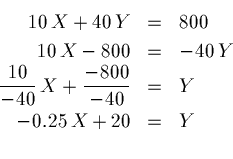Call X the number of Type A networks installed.
Call Y the number of Type B networks involved,
Then the labor constraint on skilled labor implies that
The labor constraint on semi-skilled labor indicates that
We proceed by graphing the skilled labor constraint.
First consider special case where
![]() .
This statement can be rearranged as follows,
.
This statement can be rearranged as follows,

A quick way to do this is to, recognize the equation as that of a line, know that 2 points define a line, work out 2 points on the line, in particular these 2 easy cases will do: if X = 0, then Y = 20 and if Y=0 then X = 80.
This graph shows the feasible region for the skilled labor constraint.
Now for the semi-skilled labor requirements:
![]() .
.
